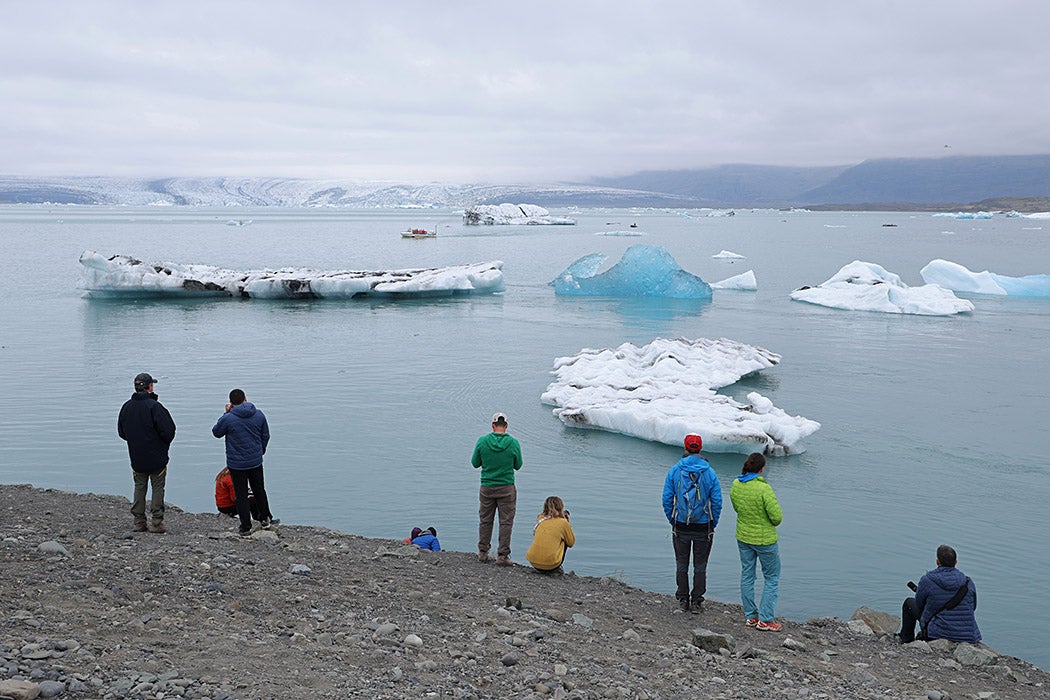As Greenland turns down further opportunities to extract coveted oil and rare earth minerals, citing environmental concerns, they are cautiously turning towards tourism to stimulate their economy. The country has invested in building infrastructure and airport terminals to support frigid thrill-seekers and their wallets. But, as a New York Times travel dispatch by Gabriel Leigh from the island briefly noted, “With jet travel a major contributor to global warming, a destination famous for its ice and snow”—such as Greenland—“will have to strike a difficult balance” of drawing just the right amount of visitors from afar (if such a possibility exists).
Greenland’s story might sound familiar to anyone who has considered an international escapade to their Arctic neighbor, Iceland, in the last decade or so. After the 2008 financial crisis, Iceland invested in attracting visitors to the cerulean lagoons and glaciers that lay beyond their airport, a common layover locale for transatlantic flights. The campaign has been so successful that tourism is now the island’s biggest industry, but locals face skyrocketing prices and hordes of tourists—a cautionary tale to Greenlanders. And, the snow- and ice-laden islands are among the first to reckon with the most extreme effects of unchecked climate change that are acutely dangerous to locals and eventual tourists alike.
As a volcanic island in the North Atlantic Ocean, Iceland is no stranger to an array of extreme geological and meteorological events. The island has fairly effective existing infrastructure that alerts locals to dangerous weather or geological events, enlisting a range of media to communicate environmental risks, including broadcasts, public meetings, email, phone calls, websites, and a mobile app. As explained in a recent paper in Mountain Research and Development by University of Iceland researchers by Matti et al., public meetings led by risk managers and scientists have been found to be “a particularly effective way to communicate information to local residents, listen to their concerns, build trust, and learn from local knowledge.”
However, the tourism sector doesn’t appear to have established comparable communication infrastructure—neither in Iceland nor globally. Despite increasingly extreme and remote tourism experiences, “both tourism and risk management literatures indicate that the tourism sector globally is poorly prepared for disasters related to natural hazards,” write Matti et al. The authors posit the gap between risk communication with locals and tourists in Iceland is particularly large, due to a significant fraction of the tourism industry being non-local—an estimated 30 percent of staff in the tourism sector and 75 percent of staff in hotels and guesthouses are not from Iceland. Other studies found that nonlocal tourism employees have “few connections to Icelandic society beyond their employer…with almost half of all foreign tourism employees reporting inadequate or nonexistent Icelandic language skills.”
This communication gap became particularly salient in June 2018, when the popular mountain Svínafellsheiði fractured, dramatically increasing the likelihood of a massive landslide in the future. As the glaciers, snow, and permafrost that buttress striking features of the Arctic landscape like Svínafellsheiði melt away, landslides and other unpredictable geological events will become increasingly likely. By parsing interviews with a variety of tourism sector participants in and around Svínafellsjökull, the mountain’s glacier, including local and foreign inhabitants, glacier guides, scientists, and tourists, Matti et al. confirmed the communication disparities were particularly acute on the topic of the Svínafellsheiði fracture. While local inhabitants were well-informed of the glacier fracture and landslide possibility, the relatively disconnected tourism employees and visitors were at best vaguely aware of the risk—raising concerns about the sector’s preparedness and safety in the face of similar events.
“All local inhabitants interviewed had a comprehensive understanding of the fracture and emergency protocols,” the researchers write, and locals frequently referred to information presented in the risk briefings with scientists—which were largely conducted in Icelandic. By contrast, though “a wide range of risk aversity among tourists was evident,” none of the tourists interviewed were “aware of the risk of a large landslide falling onto Svínafellsjökull.” One tourist mentioned safety as a top priority and understood signage near the fracture to include “some tourist information, […] and probably some safety warning,” but their group “didn’t read them.” Another tourist chose to remain blissfully ignorant of risk, while another mentioned that “natural hazards were among the experiences that attracted him to the country.”
Given the tourists’ almost willful ignorance, it is perhaps unsurprising, then, that “a common sentiment” among glacier guides, hotel receptionists, and tourism managers was feeling responsible for the safety of others. But, because the risk meetings largely targeted Icelandic-speaking local inhabitants in both outreach and format, Matti et al. found that tourism employees’ understanding of the fracture and its risks “was typically less up-to-date, less evidence based, and less technical than that of local inhabitants.” Glacier guides, who lead groups on expeditions across the glaciers, tended to be the most versed in common and overall risks that tourists face, including crevasses, rockfalls, and unstable glacial features. But, in interviews with Matti et al., glacier guides also did not mention the specific dangers of the Svinafellsheiði fracture and the possibility of landslide as particular risk concerns.
As one of the tourists and Leigh noted, partaking in an adventure in a locale like Greenland and Iceland is an acceptance—embrace, even—of a certain primacy of nature and its vicissitudes. As Matti et al. put it, “much of the sector is based on experiencing glacial, volcanic, and geothermal landscapes, all of which have inherent risks.” But, should anything amiss befall tourists, the industry’s employees are increasingly being held responsible both in tourists’ minds and in possible legal ramifications. Thus, for the benefit of tourists, tourism employees, and the countries that hope to host them, Matti et al. call for “an expansion of targeted risk management actions for the tourism sector,” particularly in locales like Iceland—and perhaps eventually Greenland.
“The weather decides,” counsels Leigh in the account of his trip to Greenland, and in the face of increasingly mercurial weather and climates, the tourism sector must also increasingly abide by those decisions.







